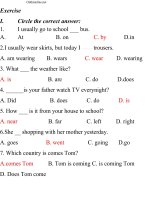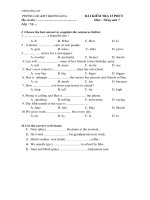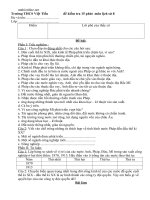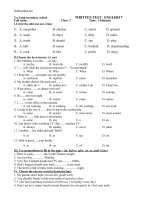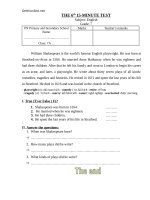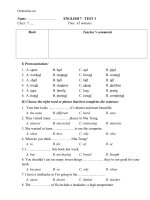- Trang chủ >>
- Đại cương >>
- Kinh tế vĩ mô
De kiem tra 15 phut Tieng Anh 8 Kha hay kho
Bạn đang xem bản rút gọn của tài liệu. Xem và tải ngay bản đầy đủ của tài liệu tại đây (88.81 KB, 2 trang )
<span class='text_page_counter'>(1)</span>PHÒNG GD&ĐT TP BUÔN MA THUỘT TRƯỜNG THCS PHAN CHU TRINH. KIỂM TRA 15 PHÚT HỌC KỲ I NĂM HỌC 2016 – 2017 Môn: TIẾNG ANH – Lớp 8 (Bài số 1). ĐỀ 1 (Trang 1) I. Multiple-choice: (5ms) Choose the best answer by blackening A, B, C or D for the following sentences. Câu 1: You can use a(n) …………… to receive messages when you are out. A. public phone B. walkman C. anwering machine D. automobile Câu 2: Rose’s French is not very good. She frequently makes mistakes A. quickly B. never C. often D. in a while Câu 3: She did it in no time at all. A. sometimes B. quickly C. always D. easily Câu 4: His wife is always …………. in the morning. She gets angry at the slightest thing. A. bad-tempered B. jealous C. imaginative D. reliable Câu 5: Can I speak to Mai, please? – ……………… A. Calling B. Answering C. Speaking D. Talking Câu 6: A ………………………… clock. A. modern big old round blue B. modern big old blue round C. modern old big blue round D. modern old big round blue Câu 7: You can usually fine a soap and ………. in a bathroom. A. folders B. shampoo C. a wardrobe D. a cupboard Câu 8: We’ve got a problem. I hope you can help …………. A. myself B. yourself C. us D. ourselves Câu 9: Choose the word whose main stress pattern is not the same as that of the others. A. interesting B. special C. excellent D. attraction Câu 10: Choose the word whose underlined part is pronounced differently from that of the others A. personal B. commercial C. furniture D. dangerous PHÒNG GD&ĐT TP BUÔN MA THUỘT TRƯỜNG THCS PHAN CHU TRINH. KIỂM TRA 15 PHÚT HỌC KỲ I NĂM HỌC 2016 – 2017 Môn: TIẾNG ANH – Lớp 8 (Bài số 1). ĐỀ 2 (Trang 1) I. Multiple-choice: (5ms) Choose the best answer by blackening A, B, C or D for the following sentences. Câu 1: We’ve got a problem. I hope you can help …………. A. us B. ourselves C. yourself D. myself Câu 2: Choose the word whose underlined part is pronounced differently from that of the others A. personal B. dangerous C. furniture D. commercial Câu 3: Choose the word whose main stress pattern is not the same as that of the others. A. attraction B. excellent C. special D. interesting Câu 4: You can use a(n) …………… to receive messages when you are out. A. automobile B. public phone C. anwering machine D. walkman Câu 5: You can usually fine a soap and ………. in a bathroom. A. a cupboard B. shampoo C. a wardrobe D. folders Câu 6: Rose’s French is not very good. She frequently makes mistakes A. quickly B. never C. often D. in a while Câu 7: His wife is always …………. in the morning. She gets angry at the slightest thing. A. imaginative B. jealous C. reliable D. bad-tempered Câu 8: She did it in no time at all. A. quickly B. sometimes C. always D. easily Câu 9: Can I speak to Mai, please? – ……………… A. Talking B. Answering C. Calling D. Speaking Câu 10: A ………………………… clock. A. modern big old round blue B. modern big old blue round C. modern old big blue round D. modern old big round blue.
<span class='text_page_counter'>(2)</span> ĐỀ 1 (Trang 2) II. Writing: (5ms) 1. Fill in each blank ONE suitable word. a. ………………. are people who can’t hear or see. b. You shouldn’t really blame …………… for that mistake. 2. Complete the sentences. Use the correct form of the words in brackets. a. Jet engines …………. (make) a lot of noise. b. Her father made her ………… (stay) in last night. c. Would you like tea or coffee? – I …………… (have) coffee, please. 3. Fill in the gaps with the correct form of the words in brackets. The “Ao dai” was ……………… (tradition) worn by men and women. 4. Rewrite each sentence so that it contains the word given in capitals, and the meaning stays the same. a. He is not old enough to ride a bike. (ALLOWED) …………………………………………………………………... b. The radio is very big. He can’t put it in his pocket. (ENOUGH) …………………………………………………….. c. Nam is short. He can’t reach the top shelf. (SUCH … THAT) ………………………………………………………. 5. Use the key words to write meaningful sentence with “enough”. He / handsome / film star? ………………………………………………………………………………………………. 6. Use the key words to write meaningful sentence. Use / mobile phone / we / not / home / office. ………………………………………………………………………….. 7. Change the following sentence into exclamatory sentences. She sings very beautifully. What ……………………………… ! How ……………………………… ! 8. Rewrite the following sentences without changing the meaning. a. You don’t have to go to school so early. It ….………………………………………………………………………... b. You mustn’t make noise in the library. You aren’t ………………………………………………………………….... ĐỀ 2 (Trang 2) II. Writing: (5ms) 1. Change the following sentence into exclamatory sentences. He sings very beautifully. What ……………………………… ! How ……………………………… ! 2. Rewrite the following sentences without changing the meaning. a. You has to improve English as soon as posible It ….……………………………………………………………….... b. You mustn’t make noise in the hospital. You aren’t …………………………………………………………………. 3. Fill in the gaps with the correct form of the words in brackets. The “Ao dai” was ……………… (tradition) worn by men and women. 4. Use the key words to write meaningful sentence. Use / mobile phone / we / not / home / office. ………………………………………………………………………….. 5. Fill in each blank ONE suitable word. a. ………………. are people who can’t hear or see. b. You shouldn’t really blame …………… for that mistake. 6. Complete the sentences. Use the correct form of the words in brackets. a. Would you like tea or coffee? – I …………… (have) coffee, please. c. Her father made her ………… (stay) in last night. b. Jet engines …………. (make) a lot of noise. 7. Rewrite each sentence so that it contains the word given in capitals, and the meaning stays the same. a. She is not old enough to see horror film. (ALLOWED) ……………………………………………………………... b. The laptop is very big. He can’t put it in his pocket. (ENOUGH) ………………………………………………….... c. Hoa is short. He can’t reach the top shelf. (SUCH … THAT) ………………………………………………………. 8. Use the key words to write meaningful sentence with “enough”. He / handsome / film star? ………………………………………………………………………………………………..
<span class='text_page_counter'>(3)</span>




